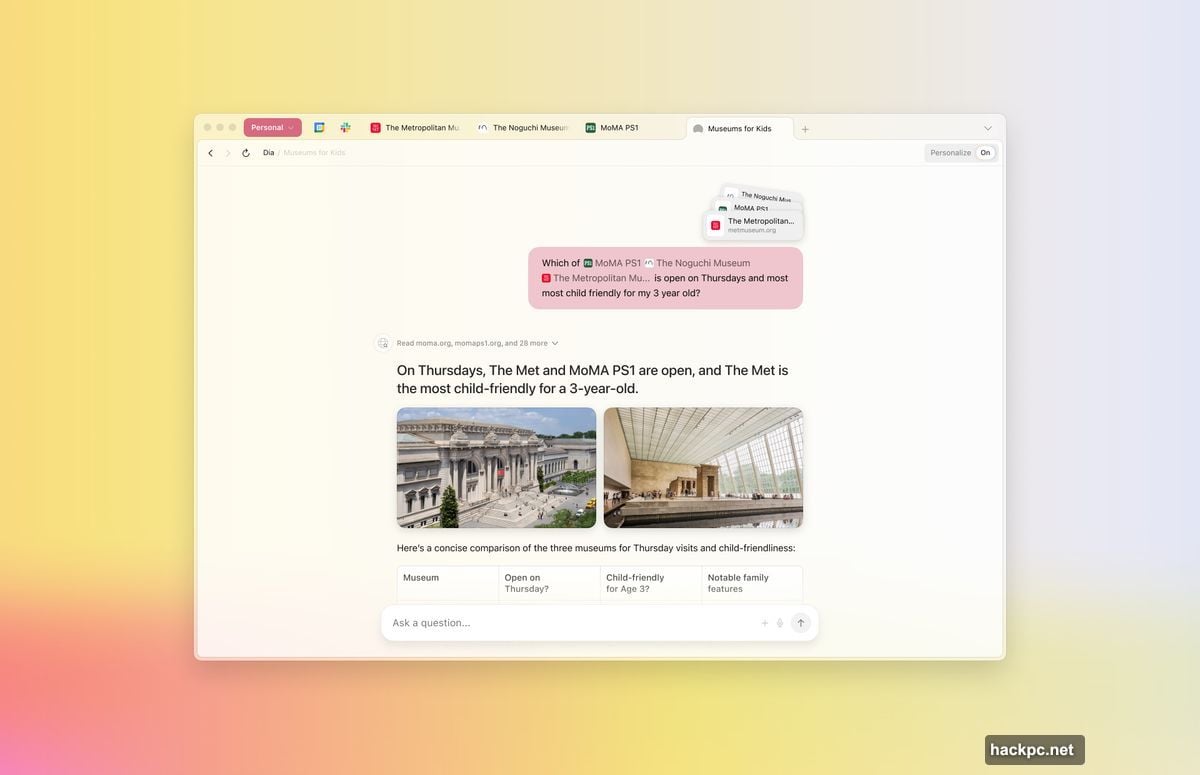
Arc Browser died too young. But its DNA lives on in something potentially better.
The Browser Company killed Arc earlier this year after admitting it was “too different” for mainstream adoption. Now founder Josh Miller revealed that Dia, their new AI browser, will resurrect Arc’s greatest hits while fixing its biggest mistakes. Plus, Atlassian’s $610 million acquisition gives them resources Arc never had.
This isn’t just recycling old ideas. It’s taking proven features and rebuilding them on better foundations.
Arc’s Best Features Return From the Dead
Dia’s latest “early birds” release just added the beloved sidebar mode. That vertical tab bar on the left edge of your screen? It’s back. So is the command palette that works like Spotlight search.
The additions keep coming. Picture-in-picture mode automatically kicks in when you leave Google Meet tabs. Custom keyboard shortcuts work exactly like Arc users remember. Pinned tabs are currently in testing.
Miller even hinted that Arc’s Spaces feature might return. Those distinct browsing areas let you separate work and personal tabs with different themes, history, and cookies. For Arc fans, Spaces were essential. For everyone else, they added confusion.

That’s the challenge Dia faces. How do you keep power features without overwhelming regular users?
Why Dia Actually Has an Advantage
Most AI browsers start from scratch. Dia doesn’t have to.
The Browser Company spent over a year learning what browser features people actually use. They watched Arc gain a devoted following among tech workers and designers. Then they watched it fail to break into mainstream adoption.
Those lessons matter more than you’d think. Building a browser means making thousands of small decisions about defaults, shortcuts, and UI placement. Arc gave them real-world data about what works and what confuses people.
Plus, Dia’s architecture handles AI better from the ground up. Arc bolted AI features onto a traditional browser engine. Dia built for AI from day one. That means faster performance and better security.
The Atlassian acquisition changes the game too. Arc operated on venture capital and hope. Dia now has enterprise resources and direct integration with tools like Jira. That opens doors Arc never could access.
The Features Still Missing
Daily Arc users know exactly what Dia still lacks. Split view for comparing documents side-by-side. The boost feature that let you customize any website’s appearance. Arc Max’s AI-powered summaries and “Ask on Page” functionality.
Some of these will return. Others might not make the cut if they added complexity without clear benefit. Miller’s actively soliciting feedback about which features matter most.
The mobile app deserves attention too. Miller promised Arc Search-inspired updates coming in 2026. But Arc’s mobile experience never matched its desktop power. Dia needs to nail this from the start.
AI Native Means Different This Time
Every browser now claims AI integration. Most just added a chatbot sidebar and called it innovation.

Dia takes a different approach with memory and agents. The browser remembers your workflows and preferences across sessions. It learns which tools you use together and when you typically switch contexts.
Agents handle repetitive tasks automatically. Need to compile research across multiple sites? The agent does it. Want to monitor price changes on specific products? The agent tracks them. This goes beyond simple automation into actual assistance.
The catch? These features only work if Dia gets the basics right first. Nobody cares about AI agents if tab management feels clunky or keyboard shortcuts don’t work reliably.
Arc Fans Already Switching
Early adopters are migrating fast. Several longtime Arc users reported they’re “so close to not missing Arc” after a few weeks with Dia. The sidebar, vertical tabs, and grid-view pinned tabs create familiar muscle memory.
But switching browsers means retraining habits built over years. Even with familiar features, the transition takes time. Small differences in shortcuts or menu placement break your flow until your brain adapts.

The Browser Company needs critical mass. If enough Arc users switch and evangelize Dia, others follow. But if the migration stalls, Dia becomes another niche browser that tech Twitter loves and everyone else ignores.
The Real Test Comes Next
Arc proved you can build something better than Chrome. It failed to prove you can get people to switch.
Dia faces the same challenge with higher stakes. The AI browser race is crowded. Every major tech company either launched or acquired an AI browser this year. Standing out requires more than good features.
The Browser Company must balance power user features with mainstream simplicity. They need enterprise adoption through Atlassian while maintaining indie credibility. And they have to move fast before competitors catch up.
Miller’s approach suggests he learned from Arc’s mistakes. Dia launches with less bloat and clearer focus. The sidebar mode arrives as an option, not a requirement. Pro features stay tucked away until you need them.
Whether that’s enough remains unclear. But resurrecting Arc’s best features while fixing its architecture problems gives Dia a real shot at success Arc never had.



Comments (0)